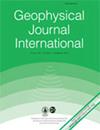求助PDF
{"title":"直接评估南开增生棱柱脚板块边界的水力结构","authors":"Joshua Pwavodi, Mai-Linh Doan","doi":"10.1093/gji/ggad473","DOIUrl":null,"url":null,"abstract":"Summary The Nankai Trough is a locus of slow slip, low-frequency earthquakes, and large magnitude (Mw > 8) earthquakes. It is usually assumed that high pore pressure contributes substantially to earthquake dynamics. Hence, a thorough understanding of the hydraulic regime of the Nankai accretionary prism is needed to understand this diversity of behaviors. We focus on the toe of the accretionary prism by studying data from Hole C0024A, part of the Nankai Trough Seismogenic Zone Experiment (NanTroSEIZE) project, that intersected the décollement at 813 meters below seafloor (mbsf) about 3 km away from the trench. We contribute to this understanding by innovatively integrating drilling and logging data to derive high-resolution hydraulic profiles along the borehole. A quantitative re-analysis of the variation in the downhole annular pressure monitored during drilling show localized fluid flow from the formation to the borehole in excess of 0.05 m3/s, especially in the damage zones at the footwall of the décollement. To validate the fluid flow profile, pore pressure was estimated independently from empirical relationships between pore pressure, porosity, and P-wave velocity, obtained from consolidation experiments and Eaton-type methods based on drilling or sonic velocity data. The formation fluids are becoming significantly over-pressurized with depth in the few hundred meters above décollement. The hydraulic profile suggests that the core of the décollement acts as a barrier inhibiting upward fluid convection, whereas the damage zone acts as an efficient longitudinal channel able to diffuse high pressure from the deeper part of the subduction.","PeriodicalId":12519,"journal":{"name":"Geophysical Journal International","volume":"61 1","pages":""},"PeriodicalIF":2.8000,"publicationDate":"2023-12-09","publicationTypes":"Journal Article","fieldsOfStudy":null,"isOpenAccess":false,"openAccessPdf":"","citationCount":"0","resultStr":"{\"title\":\"Direct assessment of the hydraulic structure of the plate boundary at the toe of the Nankai accretionary prism\",\"authors\":\"Joshua Pwavodi, Mai-Linh Doan\",\"doi\":\"10.1093/gji/ggad473\",\"DOIUrl\":null,\"url\":null,\"abstract\":\"Summary The Nankai Trough is a locus of slow slip, low-frequency earthquakes, and large magnitude (Mw > 8) earthquakes. It is usually assumed that high pore pressure contributes substantially to earthquake dynamics. Hence, a thorough understanding of the hydraulic regime of the Nankai accretionary prism is needed to understand this diversity of behaviors. We focus on the toe of the accretionary prism by studying data from Hole C0024A, part of the Nankai Trough Seismogenic Zone Experiment (NanTroSEIZE) project, that intersected the décollement at 813 meters below seafloor (mbsf) about 3 km away from the trench. We contribute to this understanding by innovatively integrating drilling and logging data to derive high-resolution hydraulic profiles along the borehole. A quantitative re-analysis of the variation in the downhole annular pressure monitored during drilling show localized fluid flow from the formation to the borehole in excess of 0.05 m3/s, especially in the damage zones at the footwall of the décollement. To validate the fluid flow profile, pore pressure was estimated independently from empirical relationships between pore pressure, porosity, and P-wave velocity, obtained from consolidation experiments and Eaton-type methods based on drilling or sonic velocity data. The formation fluids are becoming significantly over-pressurized with depth in the few hundred meters above décollement. The hydraulic profile suggests that the core of the décollement acts as a barrier inhibiting upward fluid convection, whereas the damage zone acts as an efficient longitudinal channel able to diffuse high pressure from the deeper part of the subduction.\",\"PeriodicalId\":12519,\"journal\":{\"name\":\"Geophysical Journal International\",\"volume\":\"61 1\",\"pages\":\"\"},\"PeriodicalIF\":2.8000,\"publicationDate\":\"2023-12-09\",\"publicationTypes\":\"Journal Article\",\"fieldsOfStudy\":null,\"isOpenAccess\":false,\"openAccessPdf\":\"\",\"citationCount\":\"0\",\"resultStr\":null,\"platform\":\"Semanticscholar\",\"paperid\":null,\"PeriodicalName\":\"Geophysical Journal International\",\"FirstCategoryId\":\"89\",\"ListUrlMain\":\"https://doi.org/10.1093/gji/ggad473\",\"RegionNum\":3,\"RegionCategory\":\"地球科学\",\"ArticlePicture\":[],\"TitleCN\":null,\"AbstractTextCN\":null,\"PMCID\":null,\"EPubDate\":\"\",\"PubModel\":\"\",\"JCR\":\"Q2\",\"JCRName\":\"GEOCHEMISTRY & GEOPHYSICS\",\"Score\":null,\"Total\":0}","platform":"Semanticscholar","paperid":null,"PeriodicalName":"Geophysical Journal International","FirstCategoryId":"89","ListUrlMain":"https://doi.org/10.1093/gji/ggad473","RegionNum":3,"RegionCategory":"地球科学","ArticlePicture":[],"TitleCN":null,"AbstractTextCN":null,"PMCID":null,"EPubDate":"","PubModel":"","JCR":"Q2","JCRName":"GEOCHEMISTRY & GEOPHYSICS","Score":null,"Total":0}
引用次数: 0
引用
批量引用
Direct assessment of the hydraulic structure of the plate boundary at the toe of the Nankai accretionary prism
Summary The Nankai Trough is a locus of slow slip, low-frequency earthquakes, and large magnitude (Mw > 8) earthquakes. It is usually assumed that high pore pressure contributes substantially to earthquake dynamics. Hence, a thorough understanding of the hydraulic regime of the Nankai accretionary prism is needed to understand this diversity of behaviors. We focus on the toe of the accretionary prism by studying data from Hole C0024A, part of the Nankai Trough Seismogenic Zone Experiment (NanTroSEIZE) project, that intersected the décollement at 813 meters below seafloor (mbsf) about 3 km away from the trench. We contribute to this understanding by innovatively integrating drilling and logging data to derive high-resolution hydraulic profiles along the borehole. A quantitative re-analysis of the variation in the downhole annular pressure monitored during drilling show localized fluid flow from the formation to the borehole in excess of 0.05 m3/s, especially in the damage zones at the footwall of the décollement. To validate the fluid flow profile, pore pressure was estimated independently from empirical relationships between pore pressure, porosity, and P-wave velocity, obtained from consolidation experiments and Eaton-type methods based on drilling or sonic velocity data. The formation fluids are becoming significantly over-pressurized with depth in the few hundred meters above décollement. The hydraulic profile suggests that the core of the décollement acts as a barrier inhibiting upward fluid convection, whereas the damage zone acts as an efficient longitudinal channel able to diffuse high pressure from the deeper part of the subduction.


